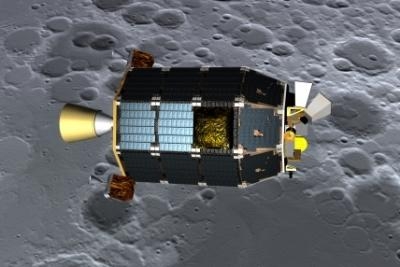Mon, Oct 28, 2013
Data Transmissions To And From Moon At 622 Mbps
NASA's Lunar Laser Communication Demonstration (LLCD) has made history using a pulsed laser beam to transmit data over the 239,000 miles between the moon and Earth at a record-breaking download rate of 622 megabits per second (Mbps). LLCD is NASA's first system for two-way communication using a laser instead of radio waves. It also has demonstrated an error-free data upload rate of 20 Mbps transmitted from the primary ground station in New Mexico to the spacecraft currently orbiting the moon.

"LLCD is the first step on our roadmap toward building the next generation of space communication capability," said Badri Younes, NASA's deputy associate administrator for space communications and navigation (SCaN) in Washington. "We are encouraged by the results of the demonstration to this point, and we are confident we are on the right path to introduce this new capability into operational service soon."
Since NASA first ventured into space, it has relied on radio frequency (RF) communication. However, RF is reaching its limit as demand for more data capacity continues to increase. The development and deployment of laser communications will enable NASA to extend communication capabilities such as increased image resolution and 3-D video transmission from deep space. "The goal of LLCD is to validate and build confidence in this technology so that future missions will consider using it," said Don Cornwell, LLCD manager at NASA's Goddard Space Flight Center in Greenbelt, Md. "This unique ability developed by the Massachusetts Institute of Technology's Lincoln Laboratory has incredible application possibilities."
LLCD is a short-duration experiment and the precursor to NASA's long-duration demonstration, the Laser Communications Relay Demonstration (LCRD). LCRD is a part of the agency's Technology Demonstration Missions Program, which is working to develop crosscutting technology capable of operating in the rigors of space. It is scheduled to launch in 2017.
LLCD is hosted aboard NASA's Lunar Atmosphere and Dust Environment Explorer (LADEE), launched in September from NASA's Wallops Flight Facility on Wallops Island, Va. LADEE is a 100-day robotic mission operated by the agency's Ames Research Center at Moffett Field, CA. LADEE's mission is to provide data that will help NASA determine whether dust caused the mysterious glow astronauts observed on the lunar horizon during several Apollo missions. It also will explore the moon's atmosphere. Ames designed, developed, built, integrated and tested LADEE, and manages overall operations of the spacecraft. NASA's Science Mission Directorate in Washington funds the LADEE mission.
(Artist's rendering of LADEE from file)
More News
“Achieving PMA for the S-1200 Series magnetos is another step in expanding our commitment to providing the aviation community with the most trusted and durable ‘firewal>[...]
Also: Bell 505 on SAF, NYPA Gets Flak For BizAv 'Abuse', FAA Venezuela Caution, Horizon Update Textron Aviation has confirmed it will be ending production of the Beechcraft Bonanza>[...]
State-Of-The-Art Common Automation Platform To Replace Legacy Systems The FAA has issued a Request for Information (RFI) regarding the initiative of the Trump Administration and U.>[...]
Kunsan Air Base Reported the Accident During Routine Operations The US Air Force has confirmed that it lost an MQ-9 Reaper drone to the South Korean waters on November 24. The airc>[...]
PowerUp S-1200 Series Approved, Available for 4- And 6-Cylinder Engines Hartzell Engine Tech announced it received FAA Parts Manufacturer Approval for its PowerUp S-1200 Series air>[...]
 Aero-News: Quote of the Day (11.27.25)
Aero-News: Quote of the Day (11.27.25) Airborne 11.26.25: Bonanza-Baron Fini, Archer v LA NIMBYs, Gogo Loses$$$
Airborne 11.26.25: Bonanza-Baron Fini, Archer v LA NIMBYs, Gogo Loses$$$ FAA Seeks Info For New Brand-New ATC Platform
FAA Seeks Info For New Brand-New ATC Platform USAF Reaper Drone Crashes Off the South Korean Coast
USAF Reaper Drone Crashes Off the South Korean Coast Hartzell Engine Tech Magneto Gains FAA-PMA
Hartzell Engine Tech Magneto Gains FAA-PMA



